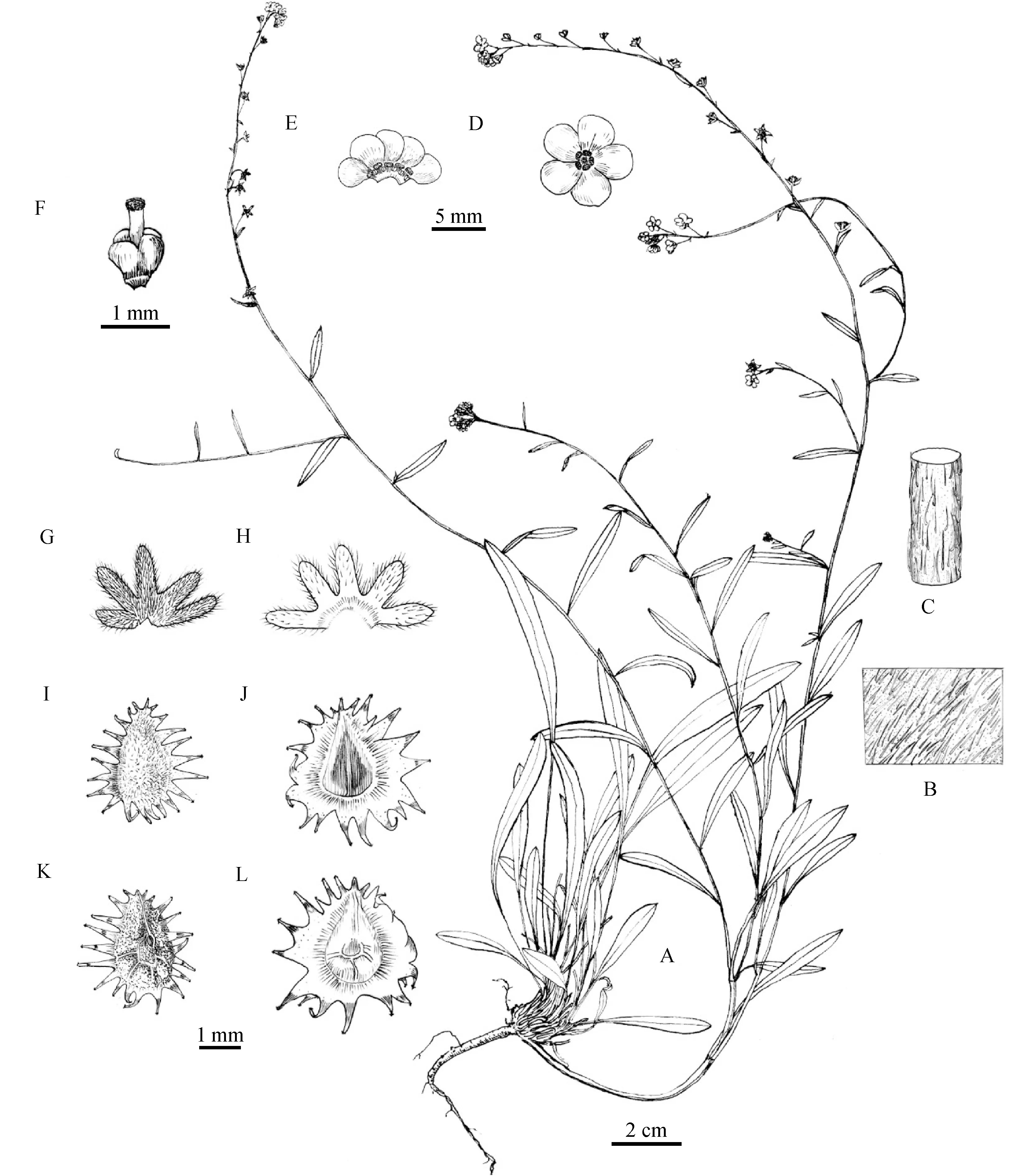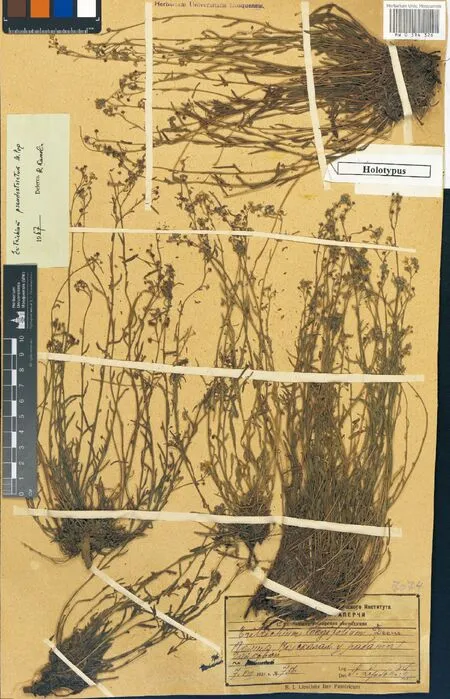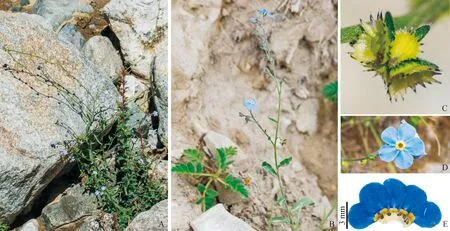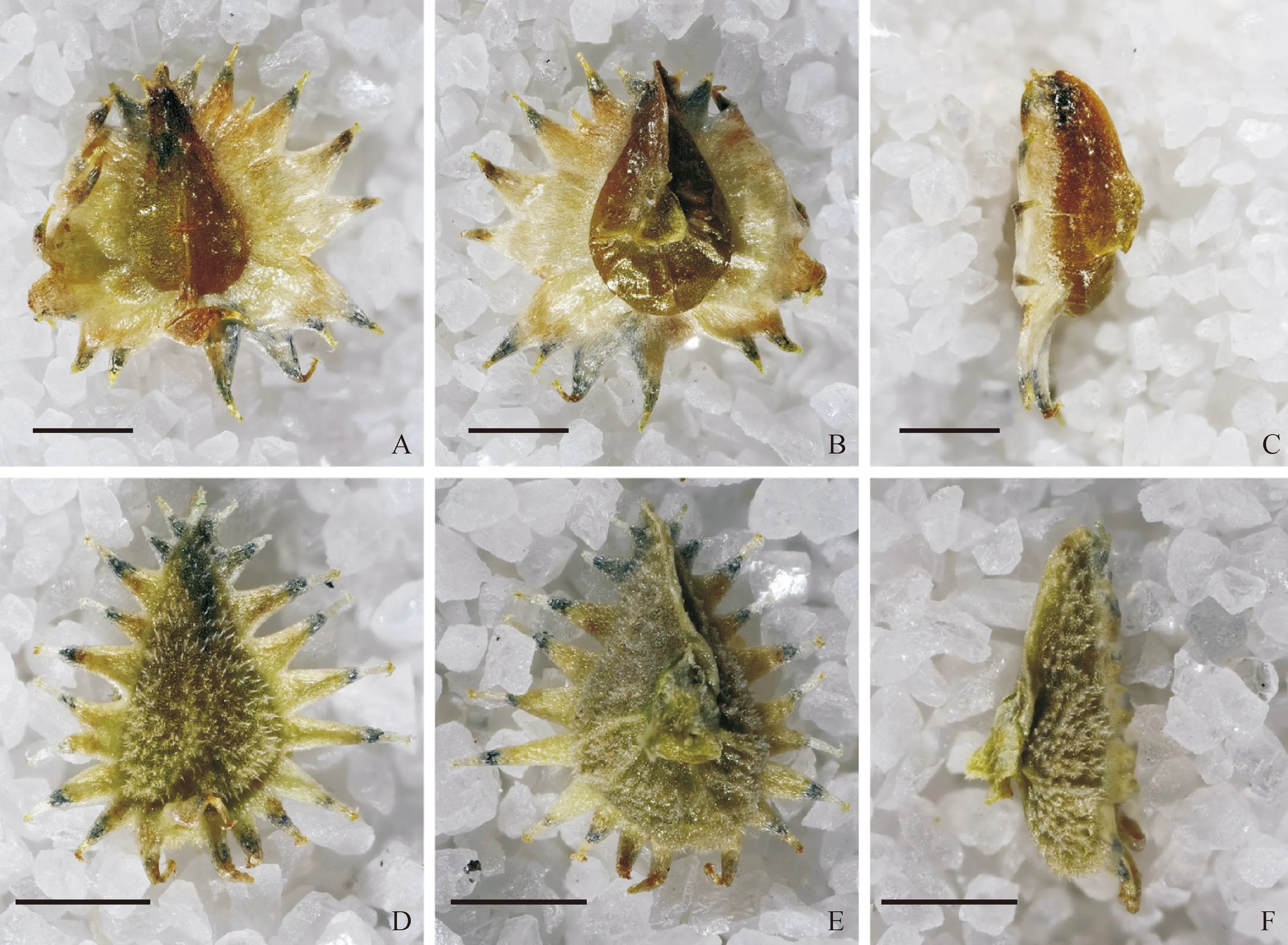A New Record of Eritrichium (Boraginaceae) in China
HAO Jiachen, LIU Quanru
(1 Beijing Botanical Garden, Institute of Botany, Chinese Academy of Sciences, Beijing 100093, China; 2 College of Life Sciences, Beijing Normal University, Beijing 100875, China)
Abstract: Eritrichium pseudostrictum, a new record from Kashgar, Xinjiang, China, is described and illustrated here, which is previously known only from Tajikistan. Supplementary description of its fruits is also provided. The voucher specimen is deposited in the herbarium of Beijing Normal University (BNU).
Key words: Boraginaceae; Eritrichium pseudostrictum; South Xinjiang; new record; China
EritrichiumSchrad. ex Gaudin[1](Boraginaceae: Cynoglosseae)[2]includes approximately 50 species which are mainly distributed in Central Asia and Pan-Himalaya, with a few species in Europe and North America[3-6].
A comprehensive study ofEritrichiumspecies was carried out nearly 40 years ago by Wangetal.[5]for theFloraReipublicaePopularisSinica[3]. They recognized 41 species including 25 endemic, distributed into 2 subgenera, 4 sections and 6 series. InFloraofChina[6], 39 species are recognized, including two described by Wang[7]. Subsequently, two additional species have been described from China by Wang[8]and Lu & Zheng[9].
As part of a revision ofEritrichiumfor theFloraofPan-Himalayas, we carried out comprehensive field investigations in various parts of China. In south Xinjiang, we found several populations of a species which could not be identified with any hitherto described taxon from China[3, 6, 8-10]. At first we thought the species is a new taxon mainly based on its heteromorphic nutlets. Then according to further revision of the herbarium material, we found the species should be identified asE.pseudostrictumPopov, a new record for China.
假劲直齿缘草 (新拟, 图版Ⅰ-Ⅳ)

图版Ⅰ 假劲直齿缘草A. 植株;B. 叶正面的毛被;C. 茎的毛被;D. 花正面观;E. 解剖开的花;F. 雌蕊;G. 花萼背面观;H. 花萼腹面观;I-J. 小坚果背面观;K-L. 小坚果腹面观;刘全儒基于标本 (郝加琛和周瑜 16929) 绘制Plate Ⅰ Eritrichium pseudostrictum Popov.A. Habit; B. Part view of adaxial leaf surface; C. Part view of stem; D. Flower in front view; E. Opened corolla, showing stamens and appendages; F. Pistil; G. Adaxial calyx surface; H. Abaxial calyx surface; I-J. Dorsal view of nutlets; K-L. Ventral view of nutlets; Drawn by Quan-Ru Liu based on the specimen (J. C. Hao & Y. Zhou 16929)

图版Ⅱ 假劲直齿缘草模式标本 (https://plant.depo.msu.ru/open/public/item/MW0594326)Plate Ⅱ Holotype of E. pseudostrictum Popov. (https://plant.depo.msu.ru/open/public/item/MW0594326)

图版 Ⅲ 假劲直齿缘草A. 植株;B. 花枝;C. 果实异型性;D. 花正面观;E. 解剖开的花Plate Ⅲ Eritrichium pseudostrictum PopovA. Habit; B. Flowering branch; C. Heteromorphic nutlets showing two glabrous nutlets with broad wings and two hispid nutlets without wings; D. Flower in frontal view; E. Opened corolla with stamens and appendages

图版Ⅳ 假劲直齿缘草果实照片 A-C. 果实光滑无毛,锚刺基部合生成宽翅;D-F. 果实具糙毛,锚刺基部分离;A、D. 背面观;B、E. 腹面观;C、F. 侧面观;标尺=1 mmPlate Ⅳ Photographs of nutlets E. pseudostrictumA-C. Glabrous nutlets with broad wings; D-F. Hispid nutlets without wings; A, D. Dorsal view; B, E. Ventral view; C, F. Lateral view; Bar=1 mm
Eritrichium pseudostrictum Popov, Fl. URSS 19: 708, 1953. (Plate Ⅰ-Ⅳ)
Type: Tajikistan. Pamir, 7 August 1931,Lipshits756 (Holotype MW0594326!; Isotype LE)
Herbs perennial, shortly sparse strigose. Root slender. Stems several, erect, unbranched or sparingly branched, (10-) 15-35 (-40) cm long. Basal leaves oblanceolate to narrowly oblong, 3-10 (-15)×0.3-0.6 (-1) cm including petiole, shortly strigose, baselly attenuate into a long petiole, apex acute; stem leaves narrowly lanceolate to linear, (0.8-) 1.5-6×0.2-0.5 cm, shortly strigose, subsessile or sessile, base attenuate, apex acute. Scorpioid cyme terminal, lax, with 10 to 25 flowers, circinate when young, gradually elongated, 6-12 (-18) cm long in fruit; all flowers with narrowly lanceolate to linear bracts. Pedicels slender, curved, 0.2-0.5 cm at anthesis, to 0.5-1 (-3) cm in fruit, sparsely strigose; Calyx lobes oblong, ca 1.3 mm long, ca 0.5 mm wide, obtuse at apex, densely strigose outside, sparsely strigose inside. Corolla blue to pale blue, sometimes white, 7-9 mm wide; lobes broadly obovate to suborbicular, ca. 3.5×3 mm, rounded to obtuse at apex; tube ca. 1.3 mm long; appendages 5, nearly trapeziform, ca. 1 mm high, yellow or pale yellow, papillose. Stamens inserted at middle of corolla tube; anthers oblong, ca 0.7 mm long, filaments short. Pistil ca. 1 mm high; style ca. 0.5 mm long, ovary with two carpels divided at maturity into 4 mericarps. Gynobase shortly pyramid-shaped, ca. 1 mm high, ca. 1.4 mm wide. Nutlets 4, heteromorphic, dorsoventrally compressed with 7-10 short glochids on each side, ca. 2×1.2 mm except glochids and wing, attachment scar at middle adaxially; broadly winged nutlets larger, glabrous, sometimes sparsely pubescent or papillose; un-winged nutlets smaller, densely hispid on both sides.
Distributionandhabitat:Eritrichiumpseudostrictumoccurs in forest, hillsides, thickets, meadows and gravelly areas of Pamirs within an elevation range of 2 600 m to 4 100 m. The species is known from Xinjiang Province (Taxkorgan, Yecheng and Shache) in China and Gorno-Badakhshan autonomous region in Tajikistan.
Phenology: Flowering and fruiting from July to August.
Conservationstatus: During our investigations in 2016, six populations ofE.pseudostrictumwere found, together with at least 1 500 mature individuals. The extent of occurrence is estimated to be more than 10 000 km2. So this species is a widespread and abundant taxon. According to the IUCN red list categories and criteria[11],E.pseudostrictumshould be categorized as ‘Least Concern’ (LC).
Notes:E.pseudostrictumwas first reported by Popov based on one collection (Plate Ⅱ) from Tajikistan[12]. As there are very few collections of this species, the previous descriptions of its nutlets were not all-inclusive. According to comprehensive fieldwork, we found two types nutlets: un-winged nutlets with hispid face (Plate Ⅳ, D-F) and glabrous nutlets with broadly wings (Plate Ⅳ, A-C), which was not described in original literature[12]. The species is very similar toE.echinocaryum(I.M.Johnst.) Y.S.Lian & J.Q.Wang in having narrow leaves, strigose hair and heteromorphic nutlets, but differs in having perennial herbs (vs. annual herbs inE.echinocaryum), larger corollas diameter (7-9 mm inE.pseudostrictumvs. 4-5 mm inE.echinocaryum), nutlets glochids without bristles (vs. nutlets glochids with bristles inE.echinocaryum).
Additionalspecimensexamined: China. Xinjiang: Taxkorgan, Kalaqigu, 37°11′02.06″N, 75°20′04.60″E, ca. 3 722 m, 20 Jul 2016, J. C. Hao & Y. Zhou 16 844, 16 848, 16 849, 16 850 (BNU!); Mazha, 37°09′15.54″N, 75°24′13.24″E, ca. 3 876 m, 19 Jul 2016, J. C. Hao & Y. Zhou 16 834, 16 835, 16 838 (BNU!). Shache, Kalatuzi coal mine, 2 800 m, 22 Jul 1987, Y. H. Wu 870 710 (HNWP!). Yecheng, Qipan County, Xuxu village, 37°28′27.59″N, 76°31′35.36″E, 2 690 m, 6 Aug 2016, J. C. Hao & Y. Zhou 16 868, 16 866, 16 869 (BNU!); Polong, 37°05′25.09″N, 77°06′19.58″E, ca. 2 895 m, 6 Aug 2016, J. C. Hao & Y. Zhou 16 926, 16 929, 16 932 (BNU!); Kekeya village, ca. 2 900 m, 5 Aug 1987, Y. H. Wu 870 861 (HNWP!). Tajikistan, Gorno-Badakhshan: 17 Jul 1935,VarivtsevaE.281(MW!); Aktash, ca. 4 100 m, 9 Jul 1953,S.S.Ikonnikovs.n.(NSK!).
Acknowledgments: The authors would like to express gratitude to Prof. Magnus Lidén (Göteborg Botanic Garden) for improving the manuscript. We also thank the curators of the herbaria E, HNWP, MW, NSK, NWTC, PE, WUK, XJA and XJBI for assistance and access to specimens. This research was financed by the National Natural Science Foundation of China (No. 31770213).

